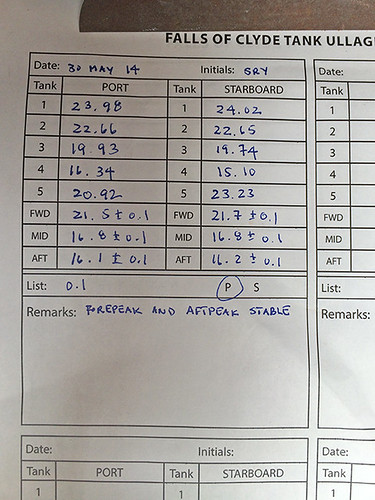After the horizon gazing of yesterday, I spent time today looking inward.
As part of my regular inspection routine, I usually check the aft- and forepeak areas and the pump room. Confession time…I’ve been lazy and have neglected the forepeak and pump room for a while. Bad, really, as they should be checked every week for any changes. There’s no excuse for not doing it, as it just involves opening the forward hatch cover or connecting an extension cord from the outlet in the boiler room to the string of lights in the area above the pump room to provide light.
The string of lights illuminates the tween deck level and forepeak, but not the pump room. The hatch provides general illumination on the tween deck level and down into the pump room, but the forepeak is usually pitch black and requires a flashlight to see anything.
I chose the hatch option today and got a surprise when I went below.
Normally hidden and unnoticed in the dark, the upper bow ports were lit by the sunlight that was streaming down through the hatch and was being reflected forward by the bulkhead separating the upper pump room area from the boiler room. It was a Newgrange moment!
Here is a shot of the entire area taken later on in the day for comparison:
The bow ports are back in shadow again.
More details.
Deck (needs sweeping):
I can’t remember if I’ve posted about this before, but these marks are something Brush noticed during the last survey:
So far, they’ve only been found on plates along one particular strake on the starboard side. No idea what they mean, if anything.
I figure I should mention the ghost(s). Oooooooo. Some time ago, I was talking to someone who had volunteered on board in the past and he told me of spooky things (voices, touch) he and someone else had experienced while working in this area at night.
At one point, some people scouting locations for a ghost hunter program visited the ship. Oddly enough, from what I understand, they said they picked up voices in the same area. Oooooooo.
I also heard that ice used to be kept in the forepeak during the ship’s sailing days and sometimes bodies would be stored there. Now, I’m not so sure about that. I guess a body could be kept, if it was someone really important. Otherwise, why not just a burial at sea?
I have had a couple of strange experiences, but they are things I can explain away. The ship has a very light and benign air…at least during the day. I’m a chicken when it comes to the dark, so I don’t think I’ll be spending any time here alone at night.
Leaving the pump room area, a valve handle on the boiler room side of the bulkhead:
I hadn’t noticed the black mark above the handle before. Caused by steam escaping a long time ago?
I made up a new ullage form, which I think works quite well:
Oops, I wrote down the wrong date.
Some life at Aloha Tower Marketplace!
It turns out that it was the people who had participated in the Challenge Nation urban scavenger race. Looks like fun!














































![[Kalama]](https://i0.wp.com/farm6.static.flickr.com/5127/5315312610_ed49094b26.jpg)




